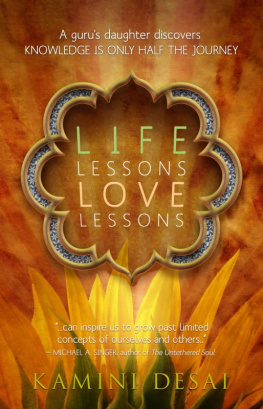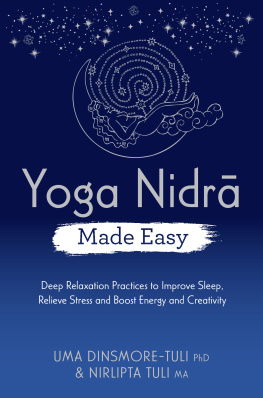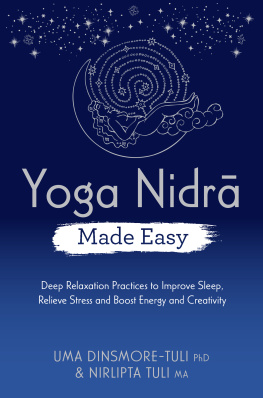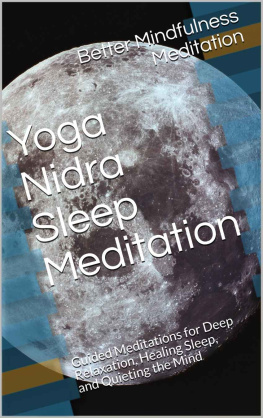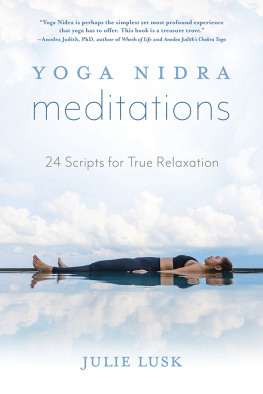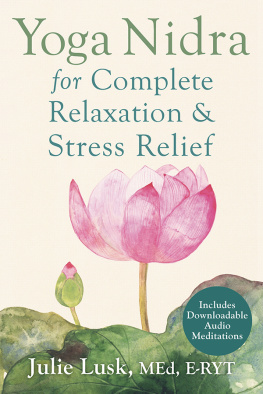YOGA NIDRA
THE ART OF TRANSFORMATIONAL SLEEP
Restore your health, reshape your life
and change your destiny.
by Kamini desai, Phd
inspired by the Teachings of Yogi amrit desai
2017, Kamini Desai, PhD, All Rights Reserved
ALL RIGHTS RESERVED. No part of this book shall be reproduced or transmitted in any form or by any means, electronic, mechanical, magnetic, photographic including photocopying, recording or by any information storage and retrieval system, without prior written permission of the publisher. No patent liability is assumed with respect to the use of the information contained herein. Although every precaution has been taken in the preparation of this book, the publisher and author assume no responsibility for errors or omissions. Neither is any liability assumed for damages resulting from the use of the information contained herein.
First Lotus Press Edition 2017
ISBN: 978-1-6086-9213-2
Library of Congress Number: 2016441639
Published by:
P.O. Box 325
Twin Lakes, WI 53181 USA
800-824-6396 (toll free order phone)
262-889-8561 (office phone)
262-889-2461 (office fax)
www.lotuspress.com (website)
lotuspress@lotuspress.com (email)
Printed In USA
Table of Contents
Yoga Nidra: The Secret Door to Freedom
The First Tool of Yoga Nidra: Realization
Yoga Nidra and Brainwaves
Understanding the Sleep that Awakens Your True Nature
Creating the Space to See
The Third Tool of Yoga Nidra:
The Fourth Tool of Yoga Nidra:
What is Yoga Nidra Doing for Me?
This book is dedicated to my beloved father and mother, whose love I have come to cherish deeply my deepest gratitude for all I have learned from you both.
Your teachings have contributed to the lives of thousands of people the world over and live on through this book.
It is my hope to make such a contribution to humanity.
Acknowledgements
I am amazed by the groundswell of support I received that has allowed this book to come to fruition. Thank you, first and foremost, to SuzAnn Gunter for your meticulous, loyal and unwavering support to get this book edited and ready for print. To Lynn Matthews, an outstanding teacher in her own right, who dedicated her valuable time to helping edit this book just because she believes in the value of this method and its healing potential. To Diane and Fred Covan who, out of appreciation for the work, volunteered to help make the book great. To Eric Walrabenstein for your friendship and the keen insights that helped hone these teachings. To the Amrit Yoga Institute and all the teaching staff who carry the essence and teachings of the Amrit Method of Yoga Nidra so beautifully. To my assistant Hamsa, who takes care of me in so many ways.
Finally, to my husband Skuli and my new family, my team, who have brought me more joy and fulfillment than I could ever have imagined.
Foreword
The year was 1972. It was near the beginning of my career as a clinical psychologist and I was working at a hospital-based clinic. The patient was thirteen years old and pregnant for the second time while her maternal grandmother raised her two year-old child. Her mother was a heroin addict; she did not know her own father. She was depressed, anxious and the only thing she looked forward to was the birth of this child. I believed my job was to get her to stop having babies while still a child herself. But she wanted this baby so somebody would love her and it would make her important. She had insight. She knew what she was doing and why she was doing it. This was the first time I clearly saw the limits of psychological insight. Mere insight would not change this girls lifestyle. Nor has it been enough for thousands of patients who have followed.
Last year, in a social setting, I met a 45-year-old Iraq War veteran. He said he was suffering from Traumatic Brain Injury (TBI) and Post-Traumatic Stress Disorder (PTSD). He reported that he was being treated as an outpatient at a VA Hospital and was taking fifteen different, powerful psychiatric medications to control his numerous symptoms. He was also receiving counseling. I subsequently learned that he committed suicide and joined the ranks of the 23 US Veterans who kill themselves each day.
Different assumptions have underscored the major approaches to psychotherapy, personal change and growth. Psychoanalysis and its many off-shoots are based on the assumption that once the historical antecedents are learned, the patient will understand why they are the way they are and will be relieved of their troubling symptoms. This is referred to as insight. Behavior Therapy and its derivations assume that changing behavior patterns through learning will result in alleviation of maladaptive behaviors. Cognitive Therapy is based on the belief that by identifying and changing negative, self-defeating thoughts, one will become symptom-free. These and most other psychotherapeutic techniques either ignore or give nodding recognition to the importance of physiological processes in the individual. On the other hand, Yoga Nidra directly addresses, focuses on, and changes habitual physiological reactive patterns. This results in actual change, healing, growth and freedom without the need to go into the story.
In my forty-five years of clinical work with every type of psychological or psychiatric problem at the front-lines of mental health struggles, I have encountered psychotics, schizophrenics, bi-polars, the depressed, traumatized, addicted, neurotic and the worried well. I have treated children, adolescents, adults and the mature in individual, couples, family and group settings. I have forensically evaluated those accused of murder, white collar and street crime. Although I am not a psychiatrist and do not prescribe psychiatric medication, I have observed their ample use in treatment throughout my career. I have studied various approaches to psychotherapy and human change, ranging from classical Freudian Psychoanalysis to Past-lives Regression Therapy, and everything in between. For at least the past thirty years, I have been impressed with the value of meditation and body-oriented approaches to therapy including massage, yoga and tai chi.
Then, last summer, my wife kidnapped and dragged me to an ashram hidden deep in the Ocala National Forest in Florida to learn Yoga Nidra meditation from a renowned master and his daughter. I was blown away.
The benefits of meditation are well-documented in a wealth of respected scientific literature. I have urged many of my patients to develop a meditation practice and often teach them deep breathing exercises, especially for treating symptoms of anxiety. While a serious and effective meditation practice is difficult to develop and maintain, Yoga Nidra is as easy as but much more effective than the breathing techniques I formerly taught. Yogi Amrit Desai perfected the ancient technique of Yoga Nidra to its current level of sophistication. His daughter went on to receive a Doctorate in Psychology and created a ground-breaking curriculum based on his teachings. In this book she integrates her traditional academic learning with Yoga Nidra for a useful guide to the modern applications of this ancient practice.
Traditional meditation requires considerable effort to empty the mind. Many individuals believe they are incapable of meditation or sitting still. Quieting the mind in that way is difficult because it is antithetical to the actual normal functioning of the brain which is always seeking answers, solving problems, and protecting us from the outside world. Yoga Nidra meditation is easy because it is based on something that the body already knows how to do: go to sleep. Through an ancient and well-designed process, the mind is guided through stages of sleep while the recipient is awake and fully conscious. The process results in the same brain wave changes that occur during deep sleep, although you are aware and awake. It can create the deepest level of meditation achieved by well-practiced Yogis. In this state, various beneficial changes occur. The consequences of stress are reversed. Blood pressure and cortisol levels drop. Heart rate slows and the body begins a process of rejuvenation and healing. The beneficial consequences of entering this state on a regular basis are that the unpleasant symptoms of insomnia, anxiety, depression, addiction and PTSD are reduced.


